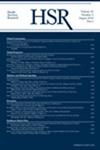Hospital-physician integration and Medicare spending: Evidence from stable angina
Abstract
Objective
To examine the association between hospital-cardiologist integration and Medicare spending for stable angina patients.
Data Sources and Study Setting
This study used Medicare Standard Analytic Files from 2013 to 2020 and the Centers for Medicare and Medicaid Services National Downloadable File for accompanying physician data.
Study Design
This was a retrospective cohort study of Medicare beneficiaries with a new diagnosis of stable angina between 2013 and 2020.
Data Collection/Extraction Methods
Patients with a new diagnosis of stable angina were categorized by whether they received care from an independent or a hospital-integrated cardiologist.
Principal Findings
Total spending for this sample was high: an average of $103,946 per patient over 12 months. Adjusted for covariates, patients of integrated cardiologists did not spend significantly more or less than clinically comparable patients of independent cardiologists (−$3856, 95% CI: −$8631 to 920, p = 0.11). This was true for overall inpatient (−$2622, 95% CI: −6069 to 825, p = 0.14) and outpatient (−1162, 95% CI: −$3510 to 1185, p = 0.33) spending as well as cardiology-specific inpatient and outpatient spending. Among high-risk patients, overall spending between the integrated and independent groups was comparable, though patients of integrated cardiologists incurred lower spending than those of their independent counterparts in inpatient care (−$13,589; 95% CI: −24,432 to −2746, p = 0.01). In a supplemental analysis, findings suggested that site-neutral payments would have resulted in lower spending among patients of integrated physicians.
Conclusions
Specific clinical settings may lend themselves to efficiencies created by integration for certain complex patients, though we do not test a causal mechanism here. Adoption of site-neutral payment policy may also lead to lower spending among patients of integrated physicians.
What is known on this topic
- Hospital-physician integration has increased significantly in the United States.
- Policymakers and health policy experts have expressed concerns that hospital-physician integration leads to increased health spending and may threaten healthcare affordability.
- While some studies link integration to greater spending, many use incomplete measures of spending, do not consider the potential benefits of care coordination, or rely on outdated data.
What this study adds
- Spending among patients with stable angina, a common cardiovascular condition, was nearly equal, on average, across patients of integrated and independent cardiologists.
- Inpatient spending on high-risk patients was somewhat lower for those under the care of integrated cardiologists.
- Overall, patients of integrated cardiologists incurred largely comparable spending relative to patients of independent cardiologists, indicating that the impact of hospital-physician integration may depend on the clinical context.

 求助内容:
求助内容: 应助结果提醒方式:
应助结果提醒方式:


